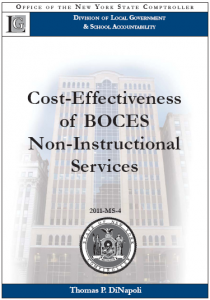 School districts share needs that can be more efficiently provided regionally, just as individual schools share needs that are more affordably provided by districts. What are we to think when the State Comptroller reports that New York’s approach to regional service sharing in the schools (BOCES) costs more than it saves?
School districts share needs that can be more efficiently provided regionally, just as individual schools share needs that are more affordably provided by districts. What are we to think when the State Comptroller reports that New York’s approach to regional service sharing in the schools (BOCES) costs more than it saves?
“Educational service agencies”—553 of them in 45 states[*]—were created to facilitate service sharing across school districts. New York State’s educational service agencies are the “boards of cooperative education services” (BOCES). Established in 1948, BOCES originally focused on rural areas, recognizing that these districts lacked sufficient scale to provide specialized services efficiently. By 1958 there were 82 BOCES across the state. After a number of mergers, 37 BOCES remain, serving all but nine of the state’s 721 school districts.
BOCES are a disparate group. Most are well-regarded in their communities and have the strong support of their member districts. Some provide only a core set of educational services, typically emphasizing vocational and special education. Others are very entrepreneurial, offering a wide range of both educational and noninstructional services, even outside their own region.
Financing BOCES
BOCES receive operating support directly from NYS and from member districts. Individual school districts are also charged for services provided to them by BOCES. New York State, in turn, provides aid to school districts to pay for services provided by BOCES—reimbursed to the district in the year after purchase. Different districts receive different levels of “BOCES aid,” determined by each district’s financial capacity and need. For a specific list of “aidable” services, BOCES aid shares from 36% of the cost in more affluent districts to 90% of the cost in the poorest ones.
BOCES aid serves as a strong inducement for school districts to use BOCES services. Even a wealthy district receives more than a third of the cost of BOCES services in the form of aid.
Does BOCES save money?
BOCES are a successful vehicle for delivering services cooperatively. Yet the promise of BOCES was that cooperative service provision would save money.
Saving individual districts money and reducing cost are not the same thing when BOCES aid is considered. Many school superintendents assert that BOCES charges more for some services than it would cost the district to provide these services individually. They employ BOCES because the aid share (again, a minimum of 36%) offsets the cost differential. A service that might cost a wealthy district $1 to provide directly will still be purchased from BOCES as long as BOCES’ price is less than $1.36.
Comptroller audit confirms BOCES cost differential
 The Office of the NYS Comptroller (OSC) recently released an audit of noninstructional services provided by BOCES (see http://goo.gl/czUNg). OSC concluded that in 60% of their “test” transactions, BOCES costs were 56% higher than the cost would have been, had the district performed the service for itself. The Comptroller’s report concluded, “the availability of BOCES Aid does not incentivize BOCES to minimize service costs, or districts to demand less expensive choices; instead, BOCES Aid shifts the burden of BOCES extra costs from local taxpayers to State taxpayers.”
The Office of the NYS Comptroller (OSC) recently released an audit of noninstructional services provided by BOCES (see http://goo.gl/czUNg). OSC concluded that in 60% of their “test” transactions, BOCES costs were 56% higher than the cost would have been, had the district performed the service for itself. The Comptroller’s report concluded, “the availability of BOCES Aid does not incentivize BOCES to minimize service costs, or districts to demand less expensive choices; instead, BOCES Aid shifts the burden of BOCES extra costs from local taxpayers to State taxpayers.”
These findings are hardly surprising (although we should not assume that they apply to all services provided by all BOCES districts). BOCES aid confers a cost advantage that creates a near monopoly for BOCES-aidable services, significantly reducing competitive pressure to contain cost.
Recast BOCES aid as block grant
Ideally, BOCES districts would offer the services that are most likely to benefit from cooperative provision. The “price wedge” created by BOCES aid, however, completely skews the decision making process:
- BOCES may choose not to offer services that would benefit from collaboration because they aren’t aidable, as the “margin” to BOCES from aidable services is so large and BOCES capacity is limited.
- Individual districts are unlikely to offer aidable services to one another, unless they can manage the arrangement through BOCES in a way that preserves BOCES aid, in effect squelching regional cooperation through any vehicle but BOCES.
- Private sector providers are also disadvantaged, unless, again, an arrangement can flow through BOCES that preserves the aid.
BOCES aid distorts prices. Incorrect prices distort decisions. Cooperation for cooperation’s sake does not save money for taxpayers or improve the education of our children. The principal reason for cooperation is to save cost, or to deliver better services.
Current BOCES aid should be converted to a block grant—individual districts would receive the same amount of state aid they now receive, but would be free to use this aid to purchase services from whomever they like—their local BOCES, a neighboring district, or a private provider. Or they can pull the service back and provide it themselves. Over time, BOCES districts would change dramatically. The more entrepreneurial and efficient would survive, even thrive, as experience with educational service agencies in Texas suggests. Others might close their doors.
If the Comptroller’s findings are remotely indicative of the cost profile of all BOCES services, this is a form of cost saving we can no longer afford. Let’s put BOCES back in the job of saving money by spurring cost effective cooperation among school districts.
[*] Association of Educational Service Agencies. See http://www.aesa.us/